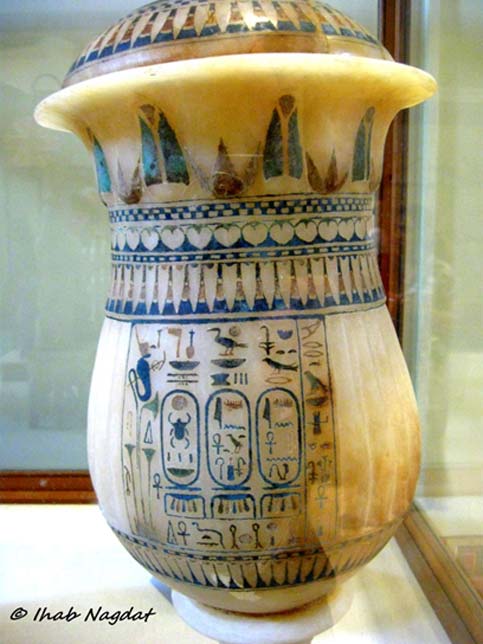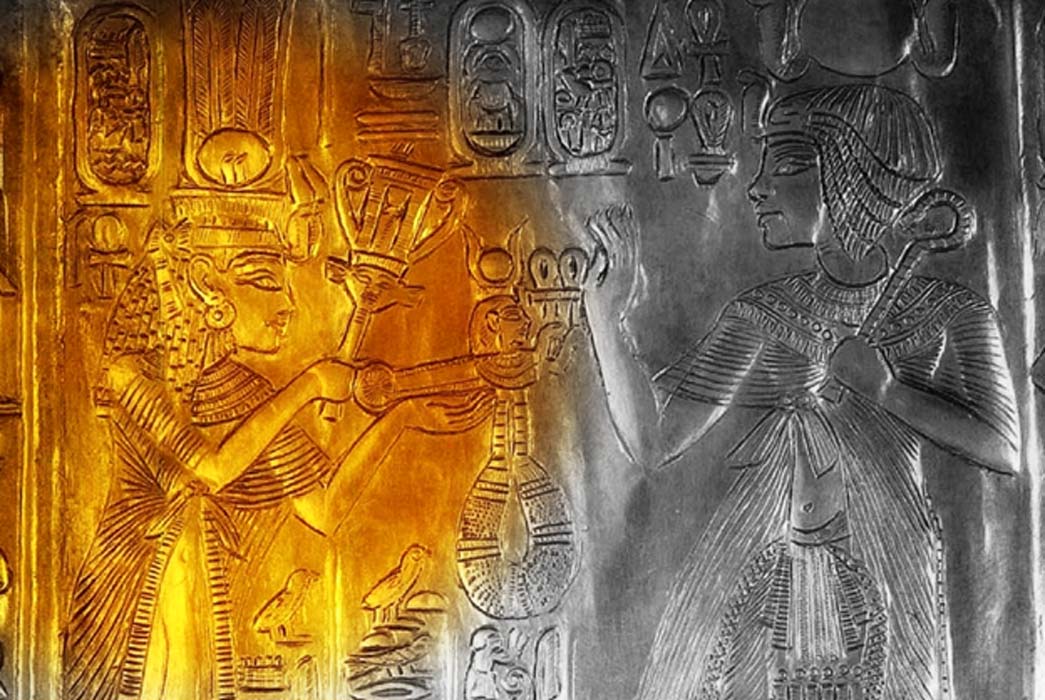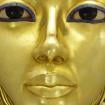Inching Closer to Ankhesenamun: Is the Last Sun Queen Set to be Found? — Part II
The probable marriage of Ankhesenamun, the widow of Pharaoh Tutankhamun, to the aged vizier Aye before she vanished from the records paved the way for the old family retainer to ascend the throne of Egypt. The latest news from the Western branch of the Valley of the Kings suggests that her tomb could well be located nearby that of the very man she probably detested and attempted to avoid entering into wedlock with. Only time will tell if the final resting place of the last sun queen will come to light and help us solve the many mysteries that surround one of the most fascinating and intriguing periods in all of ancient Egyptian history.

Detail from a dual statue, isolating the portion of goddess Mut. Amarna expert, Dr Aidan Dodson, opines that this sculpture from the Luxor Temple cache, likely represents the physiognomy of Queen Ankhesenamun. However, not all Egyptologists agree with this identification. Luxor Museum. (Photo: Victor Solkin)
Foundation Deposits Hold Great Clues
The fate of the Amarna royals was plunged into darkness when the Atenist experiment ended following the demise of Pharaoh Akhenaten and the departure of the enigmatic ruler, Smenkhkare, from the scene. Ankhesenamun stepped in to save the day by marrying her half-brother Tutankhamun at this time. But the fortunes of the dynasty suffered a huge blow with the young king’s sudden death, and once again, she was thrust into the spotlight. However, no one knows what became of Ankhesenamun beyond the assumption that she married the next monarch, Aye. But if recent reports from the Egyptian Ministry of Antiquities are anything to go by, all that could well change in the days ahead.
Following the discovery of tomb KV63 in 2005 by a team of archaeologists led by Dr Otto Schaden, speculation arose that it was designed for Ankhesenamun due to its proximity to the tomb of Tutankhamun. Though no mummies were found, the chamber yielded coffins, storage jars and natron that indicated it was likely an embalmers’ cache. More importantly, clay seal impressions with the partial name ‘Pa-aten’ were also discovered. The only royal person known to bear this name from that period was Ankhesenamun (birth name, Ankhesenpaaten).

This monumental dyad was pieced together from fragments in the vaults of the Cairo Museum and those found at the Temple of Amun in Karnak, where it originally stood in the hall to the north of the obelisk of Hatshepsut. Dr Aidan Dodson states: “It seems certain that the Amun and Mut statues have the faces of Ay and Tey.” Egyptian Museum Cairo.
Between 2007 and 2011, the Egyptian Supreme Council of Antiquities undertook a comprehensive program of excavation and survey in the Valley of the Kings. It was the first such effort at the site by an all-Egyptian team of archeologists. The mission, conducted under the auspices of Dr Zahi Hawass, the then Secretary General of the Supreme Council, consisted of Afifi Rohim Afifi as field supervisor, and several Egyptian team members. This expedition was the largest since Howard Carter discovered Tutankhamun’s tomb in 1922.
Within the scope of the excavation, permission was granted to Glen Dash and his team of experts from the Glen Dash Foundation to undertake a targeted geophysical survey. The mission report states that they identified many new inscriptions, and more importantly, discovered four intact foundation deposits - which are votive offerings placed in, beneath, or around a tomb, temple or other structure, usually at its commencement - from the westernmost end of the Western Valley of the Kings.

An all-Egyptian archeological mission headed by Dr Zahi Hawass; field supervisor Afifi Rohim Afifi, and Glen Dash and his team of experts have identified a site near King Aye’s tomb in the Western Valley as the spot where a late Eighteenth Dynasty tomb could be located.
At the start of excavations, a multiplicity of workmen’s huts were mapped; which upon clearance down to the bedrock exposed four deposits arrayed around a central hut. The team found that the placement of artifacts in these deposits was similar to their arrangement in the deposits discovered by Howard Carter in front of the tomb of Amenhotep III (WV22). Carter reported that objects there were ‘placed en masse’ - the only visible order being that flesh offerings were always on top, followed by pottery. Among the objects were 18 flat-bottomed offering bowls, a blue painted jar with a rounded base, two miniature tools with handles, and a well-preserved bovine skull. The blue painted jar enabled the team to date the deposits to the Eighteenth Dynasty.

(Clockwise: top left) The position of the four foundation deposits found in the Western Valley; (top right) the general layout of the site; (bottom) examples of the range of artifacts that the foundation deposits yielded during the Affifi and Dash excavations in 2011. (Photos: Afifi Rohim Afifi and Glen Dash/Egyptian Ministry of Antiquities.)
Artifacts Point to a Tomb?
What do these finds mean and during whose reign were the foundation deposits placed? The mission report explains that the evidence seems to point to the Amenhotep IV/Akhenaten period. “Nothing encountered is inconsistent with the hypothesis proposed by Schaden and Wilkinson that WV24 and WV25 were begun by Amenhotep IV/Akhenaten before he moved the royal house to Amarna. Indeed, the relative positions of WV23, WV24, WV25, and the foundation deposits suggest that they may all have been conceived of as part of one complex. However, none of these tombs were completed until after the Amarna period, when the royal house returned to Thebes, finishing what eventually became the tomb of Ay,” the mission report explains, and adds, “We can reasonably date the deposits to the 18th dynasty. The deposits lie on a line that runs ‘local east’ from the axis of the tomb of Ay, suggesting that this tomb and the deposits are related.”
On July 7, 2017, National Geographic Italia published an interview-article about the discovery of a new tomb in the Western annex of the Valley of the Kings.
It was disclosed that based on the four foundation deposits containing votive objects such as pottery vessels, food remains and tools, archeologists suspected it was the site of a tomb construction. Thus far, only a handful of foundation deposits have been discovered in the Valley of the Kings; and a miniscule percentage have been retrieved intact. The article also revealed that ground-penetrating radar tests detected “a substructure that could be the entrance of a tomb”. This mysterious construction was identified outright as Ankhesenamun’s sepulcher.

This splendid alabaster vase from KV62 has three cartouches bearing the names of Tutankhamun and his consort, Ankhesenamun. Egyptian Museum, Cairo.
In an update to Live Science, Dr Hawass explained that until excavations got underway it cannot be assumed that a tomb has been discovered, for there may not be one at all. Subsequently, in a free-wheeling, exclusive interview with the present writer, the author of that report, Owen Jarus, said, “Hawass wanted to inject some caution into the comments he had emailed me the day before; so he said: “We are sure there is a tomb there, but we do not know for sure to whom it belongs.” That sounded very definitive; and I think he wanted to clarify that this isn’t yet a done deal.”
On January 19 this year, an official release from the Secretary General of the Supreme Council of Antiquities, Dr Mostafa Waziri (published on Facebook) confirmed that the mission is working in the area in front of Aye’s crypt; and added that the foundation deposits retrieved in 2010 indicated the existence of a tomb. This was backed up by details published on Hawass’s website: “The radar scans in the area detected the presence of an entrance to a tomb at a depth of 5 meters (16 feet).” This excavation project is funded by Discovery Channel.

The demonstration of affection in this detail showing two of Akhenaten’s daughters – probably Meritaten and Ankhesenamun – is typical of the intimacy allowed in representations of the royal family during the Amarna period. Metropolitan Museum of Art, New York.
Excitement and Doubts Abound
Not all are convinced that the tomb about to be uncovered will contain the remains of Ankhesenamun. A section of scholars believe there’s little reason for the latest excitement that’s brewing in the Egyptological world. They contend that Ankhesenamun has already been positively identified as one of two mummies – apparently of Eighteenth Dynasty queens – found in KV21 in the Valley of Kings. This tomb, discovered by Giovanni Belzoni in 1817, was re-excavated and cleaned in 1990 by Donald P. Ryan for the Pacific Lutheran University.
The bare and undecorated tomb was in poor condition owing to torrential downpours that pummel the Valley from time to time. Thus, both mummies were ill-preserved. In 2010, DNA analysis backed by a multidisciplinary team headed by Carsten Pusch, a geneticist at the University of Tübingen in Germany stated: “The data obtained from KV21A points to this mummy as the mother of the fetuses (found in the tomb of Tutankhamun). Unfortunately, we are not yet able to identify her as Ankhesenamun, Nefertiti’s daughter.”

The reconstructed sarcophagus of King Aye rests in the burial chamber of his tomb. Western Valley of the Kings (WV23). J.G. Wilkinson described what he saw: “Contains a broken sarcophagus and some bad fresco painting of peculiarly short and graceless proportions”. (Photo: Daniel Beck/Amun-Luxor)
Egyptological researcher, Anneke Bart, also believes Ankhesenamun was buried with a female relative in KV21, “Ankhesenamun and Tey would presumably be buried during the reigns of Aye/Horemheb. I would be more inclined to seek Queen Mutemwia (mother of Amenhotep III) or Sitamun (daughter and Great Royal Wife of Amenhotep III) as possibly having a tomb in the King’s Valley. After all, Yuya and Tuya were buried there as well; and KV40 seems to have functioned as a tomb for lesser royals during the Tuthmosis IV/Amenhotep III period.” Her thoughts find support from leading Egyptologist, Dylan Bickerstaffe, “That burial near WV23 need not be a female connected to Ay’s tomb.” But Brian Alm notes, “As to Ankhesenamun, if she's not in Amarna, and if she wasn’t dumped somewhere after marrying Ay and disappearing, I can’t think of a better place for her than the Western Valley.”

Mounted on a sled, the large gilded shrine found in the KV62 Treasury contained the embalmed organs of Tutankhamun within a calcite canopic chest. Between the posts, on each of the four sides of this monument, stood an elegant guardian goddess of gilded wood – Isis, Nephthys, Neith and Serket – with outstretched arms. Some scholars have postulated that these exquisite figures represent Ankhesenamun; but this cannot be ascertained. Egyptian Museum, Cairo.
Assuming that it is indeed Ankhesenamun who lies buried near WV23, could it be that her tomb and that of her husband and half-brother, Tutankhamun, were built simultaneously after the seat of power shifted back to Thebes from Akhetaten? This could mean that Aye merely usurped the boy-king’s unfinished gravesite, because he had legitimized his right to rule by marrying the widow; and thereby, the burial arrangement changed drastically to separate the blue-blooded children of Amarna in death.
Egyptologist Dr Carolin Johansson is cautious in her approach: “Finding an Amarna-era cache would probably be the most “rewarding” historically speaking. However, we don’t know if this structure is (1.) a tomb (2.) attributed to Amarna (3.) or that it contains inscriptions or objects which can further our knowledge about that period. My instinct tells me that if at all a discovery is made, it is going to raise more questions than provide answers.”
Special thanks to Dr Aidan Dodson and Dr Carolin Johansson for their inputs in this series.
All photos that show details of the Western Valley excavations and foundation deposits are courtesy the Egyptian Ministry of Antiquities.
[The author thanks Victor Solkin, Heidi Kontkanen, Mohamed A Fahmy, Ihab Nagdat, Brian Alm, and Daniel Beck/Amun-Luxor for granting permission to use their photographs in this series. The public archives of the Metropolitan Museum of Art can be accessed here.]
--
Top Image: Detail from a replica of the small golden shrine found in KV62 that shows Ankhesenamun and Tutankhamun; design by Anand Balaji (Photo credit: Anneke Bart); Deriv.
By Anand Balaji
Independent researcher and playwright Anand Balaji, is an Ancient Origins guest writer and author of Sands of Amarna: End of Akhenaten.
References
Current Research in Egyptology: Proceedings of the Fifteenth Annual Symposium, University College London & King’s College London, 2014
Afifi Rohim Afifi and Glen Dash, The Discovery of Intact Foundation Deposits in the Western Valley of the Valley of the Kings, 2014
Nicholas Reeves and Richard H. Wilkinson, The Complete Valley of the Kings, 2008
Aidan Dodson, Amarna Sunset: Nefertiti, Tutankhamun, Ay, Horemheb, and the Egyptian Counter-Reformation, 2009
Marianne Eaton-Krauss, The Unknown Tutankhamun, 2016
Alessandra Clementi, Sulle tracce di Nefertiti, National Geographic Italia, 7 July 2017
Owen Jarus, King Tut's Wife May Be Buried in Newly Discovered Tomb, Live Science, July 18, 2017
Owen Jarus, Archaeologists Begin Search for Tomb of King Tut's Wife, Live Science, January 16, 2018
Dr Bob Brier, (Documentary) The Great Egyptians: The Mystery of Tutankhamun, 1998
Joyce Tyldesley, Chronicle of the Queens of Egypt, 2006
Dodson A. and Hilton D., - The Complete Royal Families of Ancient Egypt, 2004




















Comments
Its just really fabulosu to have this great blog post. I really like this and surely will share this others,